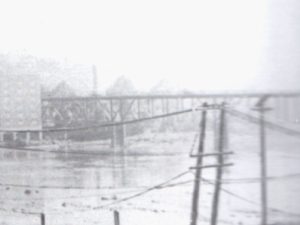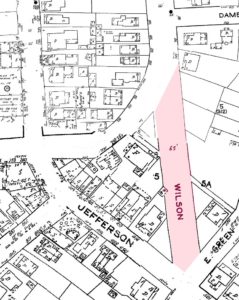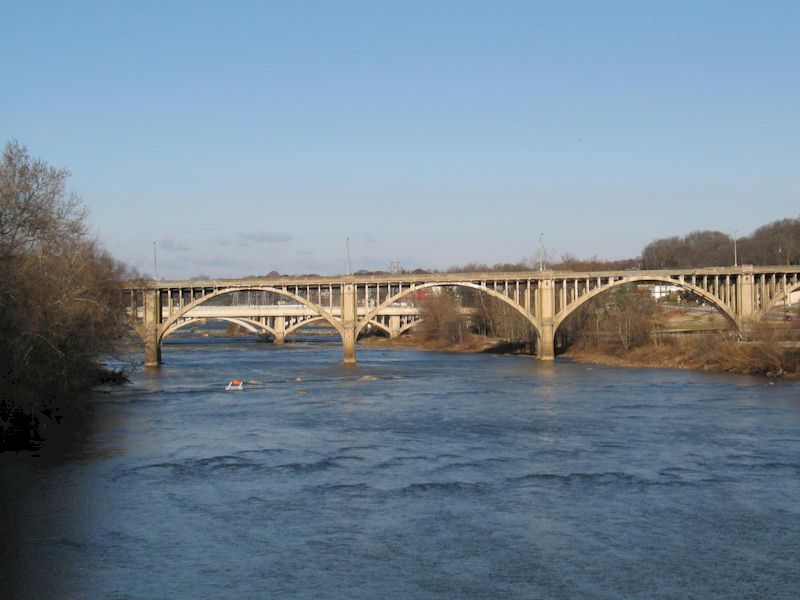What does the Worsham Street Bridge have to do with the Old West End? Actually, quite a bit, but perhaps we should begin by addressing the Worsham Street Bridge itself.
The original bridge extended Worsham Street on the north side to the Tobacco Warehouse District on the south, dead ending at Bridge Street. It was smaller iron-and-wood bridge built in the early 1900s, the highest bridge across the Dan. It was used primarily by foot traffic and for farmers bringing their wagons to the tobacco markets. Its only known photo is shown below.

This bridge was not fit for the heavier car and truck traffic of the 1920s and was replaced. Some of the iron from the old bridge was immediately reused on the Jefferson Avenue Extension Bridge between Main Street and Grove. That same iron is now embedded in the Danville Museum of Fine Arts and History. We wrote about this nearly three years ago.
The second Worsham Street Bridge, pictured at the very top, was completed in 1928. This much-anticipated bridge was an open spandrel reinforced concrete arch bridge, one of the longest and tallest of its type. The bridge helped relieve traffic congestion on the Main Street Bridge two blocks to the northwest. However, the dead end of Worsham Street on the south side made traffic on Bridge Street much worse. Talk immediately began about connecting the new bridge to Wilson Street through two blocks of warehouses and businesses.
Our recent article about the northwest corner of Jefferson and Loyal Streets reported on the Jefferson Avenue Improvement Corporation (JAIC). The JAIC expected the new bridge to make the Five Forks area a second downtown. The connection between Worsham Street and Wilson Street and the widening and straightening of Wilson Street were key to this plan. Some of the city’s most prominent citizens petitioned City Council for this work to be completed. However, those same prominent citizens had also invested in the JAIC and purchased properties along Wilson and Loyal Streets. The 1928 Council punted this question to their successors.
Debate on the Worsham / Wilson Street project continued for many years. The board of the Hughes Orphanage, made up of many of the same prominent citizens, even offered the city a $7,000 “payment” if the work was completed by 1940.
The question was finally resolved in 1947 by a bond referendum for street improvement stalled by the war. With cars becoming commonplace, traffic was seen as a menace. Before the vote, an editorial in The Bee suggested, “the extension of Wilson street so as to join with the Worsham Street bridge – on of the projects in the coming bond issue – fits in so well with … coping with modern traffic conditions.” Another editorial noted that street improvements would reduce “the temptation to create suburban shopping centers with parking space – something which seems to be catching the fancy of the buying public in other cities.” The voters agreed, authorizing the city to issue $1.5 million in bonds.

The Worsham / Wilson Street project, anticipated in 1927, was finally completed in 1950. This included the straightening and extending of Wilson Street to intersect Green Street at Jefferson Street in Five Forks – shown at right. The surrounding area was also rezoned from Residence to Business.
Did this have the desire effect on Five Forks businesses and property values? Perhaps for a time. But like other downtown business, the shops and restaurants here declined as suburban shopping centers were built north of the river. Then, following a decade of weight reductions, the second Worsham Street bridge was closed to traffic in 2004 and demolished in 2009. Wilson Street is now lightly traveled, some buildings have been demolished, and those that remain are mostly vacant. But now, with the revitalization of the Old West End and the burgeoning River District just blocks away, Five Forks again holds promise.
